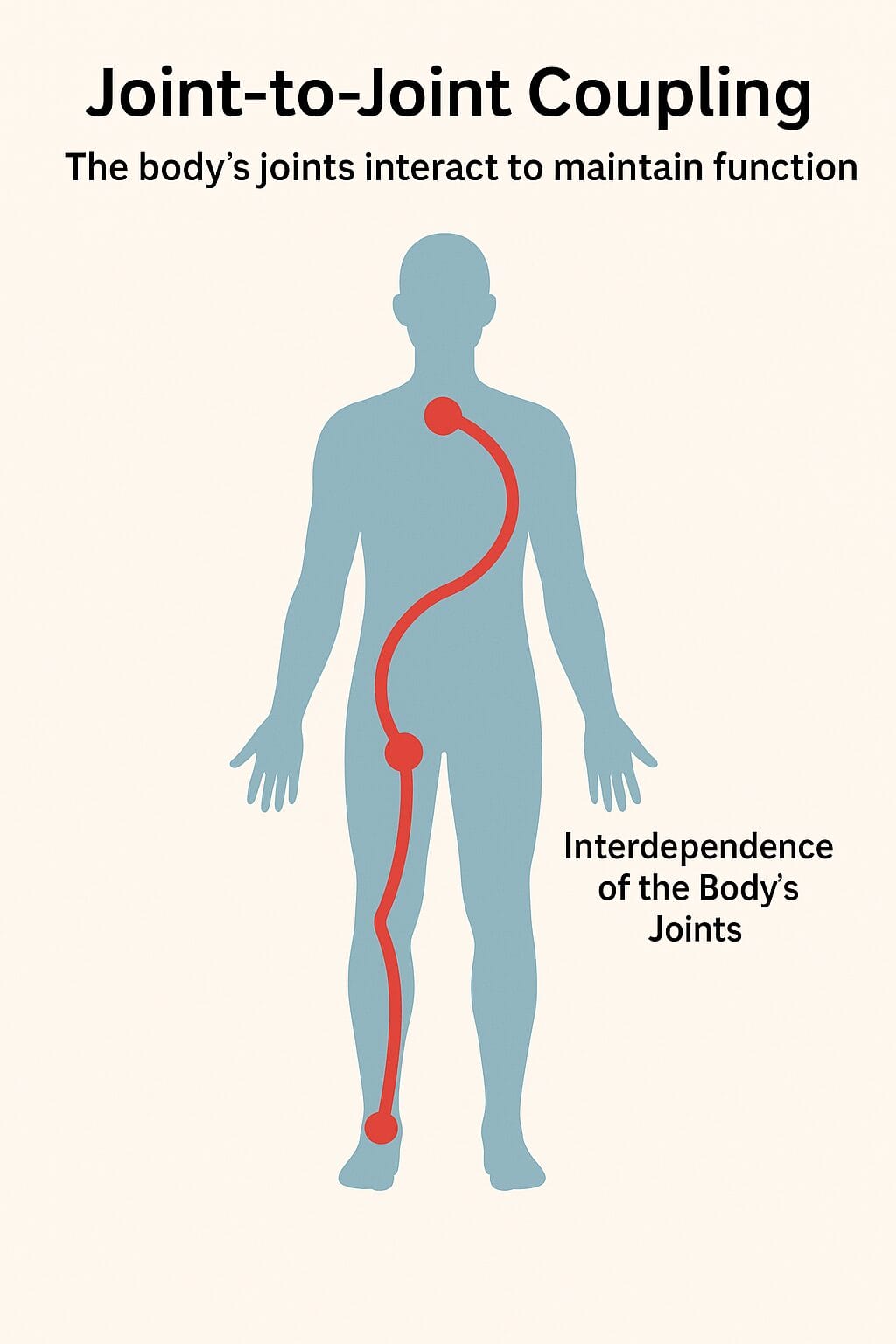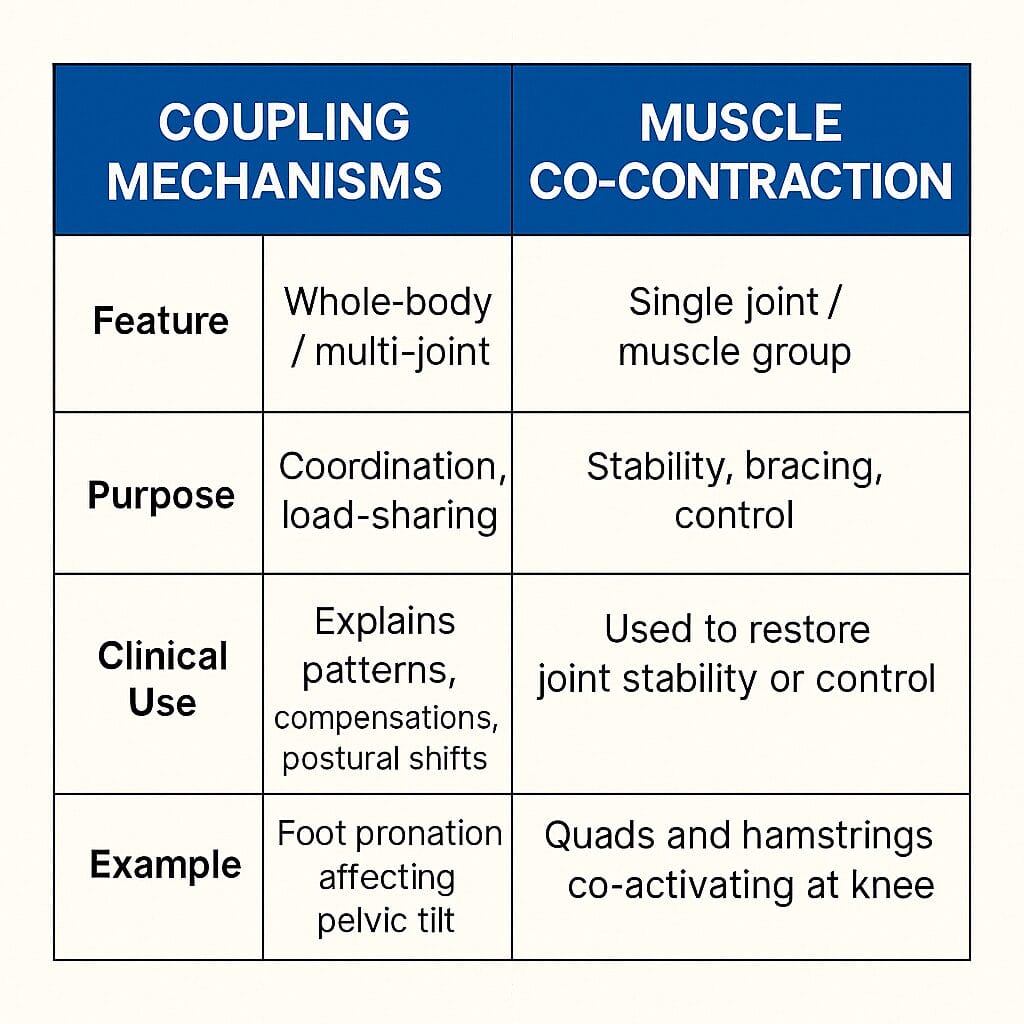Coupling Mechanisms: Why the Body Moves as a System, Not in Parts.
- Updated - April 16, 2025
Have you ever noticed that turning your head slightly changes your balance? Or does that tightness in your calves affect your hips or shoulders? That’s not a coincidence. It’s how the body operates through coupling mechanisms.
At PostureGeek, we say: “The body never moves in isolation.” Every action, posture, and adjustment is part of a larger movement pattern involving interconnected systems. When one body region is affected, another responds, even if that response is subtle or delayed. Understanding these relationships helps explain everything from recurring pain to unexpected performance gains, and it’s a cornerstone of integrated bodywork, functional movement analysis, and posture correction strategies.
Whether you’re a practitioner, a movement educator, or someone trying to make sense of your chronic aches and misalignments, exploring coupling mechanisms will change how you view the body. It helps shift our thinking away from isolated muscle work and toward restoring system-wide harmony.
What Are Coupling Mechanisms in the Body?
Coupling mechanisms refer to the way different regions of the body work together during movement. These mechanisms help coordinate motion, distribute load, and maintain balance. Movement or tension in one area naturally influences others through mechanical, neuromuscular, and fascial links.
For example, poor ankle mobility might lead to altered hip mechanics, or a tight thoracic spine could restrict shoulder range. These kinds of interactions can lead to compensations, overuse, and discomfort. Recognizing how regions influence each other and addressing them with thoughtful interventions is key to effective treatment and long-term resilience.
This concept is central to understanding functional movement, postural assessment, and why pain or dysfunction often travels across regions. Let’s explore the four major types.
1. Joint-to-Joint Coupling (Kinematic)

Some joints are designed to move together. This is due to the orientation of bones, ligaments, and joint surfaces. These built-in biomechanical pairings are essential for smooth, functional movement.
- Spinal example: In the lumbar and thoracic spine, side bending typically couples with rotation. The anatomy of the facet joints governs this motion.
- Pelvic-lumbar example: An anterior pelvic tilt causes lumbar extension. A posterior tilt causes lumbar flexion.
These patterns are predictable and play a key role in postural integrity. When disrupted through restriction, pain, or habit, the body compensates, often drawing on other joints or muscles to pick up the slack. These compensations may not be painful initially but can contribute to movement dysfunction, postural imbalances, or repetitive strain injuries over time.
Discover a practitioner near you.
Looking for a practitioner near you? Our extensive network of qualified professionals is here to help you.
2. Muscle Pattern Coupling (Neuromuscular)

The body relies on coordinated muscle firing patterns to maintain posture and generate movement. This includes reflexive stabilization before and during motion. These patterns are refined through development and are essential for efficient motor control.
- Overhead reaching: The core activates in advance to stabilize the trunk. This pre-activation prevents the spine from collapsing or overextending during motion.
- Gait: The right arm swings with the left leg, a classic cross-pattern that enhances efficiency, balance, and propulsion.
When these neuromuscular couplings are disrupted by injury, chronic pain, or poor movement habits, they can lead to faulty movement strategies, inefficient force production, and increased risk of injury. Restoring these natural sequences through rehab, movement retraining, and cueing strategies can dramatically improve coordination and reduce compensation.
3. Fascial Coupling
Fascia is a continuous web of connective tissue that spans the entire body. It allows tension to be transmitted across regions, often influencing posture and pain far from the source. Unlike muscles, fascia does not contract but adapts and responds to mechanical stress, hydration, and neural input.
- Posterior chain example: Plantar fascia tension can impact hamstrings, pelvis, and even the spine. This is often seen in people with flat feet or limited ankle dorsiflexion.
- Breathing example: Diaphragm restriction affects thoracic mobility and pelvic floor coordination. Breathing dysfunction can manifest as neck tension or core weakness.
Fascial coupling highlights the importance of looking beyond local symptoms. A neck problem may not be just about the neck. It may be influenced by pelvic tilt, foot posture, or breath mechanics. Whole-body treatment strategies, including myofascial release, movement re-education, and postural alignment work, can help restore optimal tension and integration across fascial planes.
4. Load Transfer and Structural Coupling
Efficient movement depends on the body’s ability to transfer load across segments. When a weak link exists due to injury, instability, or dysfunction, the system adapts. That adaptation often leads to overuse, strain, or injury elsewhere.
- Pelvis-core integration: The thoracolumbar fascia connects glutes to opposite-side lats, enabling powerful gait and rotation. This fascial sling transfers load diagonally across the body during walking or running.
- Foot-to-jaw example: Poor foot mechanics can cascade up the body, altering pelvic alignment, spinal curves, and jaw tension.
Breakdowns in load transfer are often the underlying issue in chronic pain or recurring injuries. Rebuilding structural coupling through alignment correction, strength integration, and movement variability allows the body to absorb and distribute forces more effectively.
How Is This Different from Muscle Co-Contraction?
Muscle co-contraction involves simultaneously activating opposing muscles around a joint for stability. It’s local, often temporary and useful in rehab or balance training.
Coupling mechanisms, by contrast, are system-wide relationships. They involve chains of joints and tissues moving together with purpose and efficiency. Rather than bracing one joint, coupling spreads responsibility across the kinetic chain.

When coupling breaks down, the body may over-rely on co-contraction, leading to rigidity and inefficient movement. You might see someone bracing their core unnecessarily while walking or clenching their jaw while performing a simple balance task. These are protective patterns born from a lack of global coordination.
Restoring movement integration helps reduce unnecessary bracing and improves functional adaptability. When the whole system works together, local areas no longer need to overwork to create stability.
Why Coupling Mechanisms Matter
Recognizing coupling mechanisms transforms how we understand posture, pain, and performance:
- Chronic pain that moves around: Symptoms shift locations because of interconnected compensation.
- Recurring injuries despite isolated treatment: The real issue is often upstream or downstream from the pain.
- Feeling “off” without an apparent injury: Coupling disruptions cause poor load handling and subtle fatigue.
- Plateaued performance or movement efficiency: Poor coupling means more energy is wasted and more stress accumulates.
Practitioners who understand these patterns can assess more intelligently and intervene more precisely. Clients gain a new awareness of their bodies and are empowered to address root causes rather than chase symptoms. Instead of asking, “What hurts?” we begin asking, “What’s not coordinating?”
What You Can Do
- Notice patterns. Does your shoulder react when you walk barefoot? Does neck tension change your balance? These are signs of systemic movement relationships.
- Work with whole-body practitioners. Seek care from professionals who understand regional interdependence and integrated assessment.
- Prioritize quality over quantity. Focus on smooth, controlled motion across regions instead of isolated performance goals.
- Restore coordination. Practice breathwork, cross-pattern movements, and dynamic drills that support neuromuscular integration.
- Use visual and sensory feedback. Mirrors, slow-motion video, and tactile cueing can reveal coupling breakdowns you may not feel.
- Explore alternative inputs. Consider tools like resistance bands, bodyweight play, or dynamic surfaces to stimulate better load distribution and movement adaptability.
- Be patient. Restoring coupling isn’t a quick fix. It’s a practice of refinement. Small shifts in awareness and movement habits lead to significant changes in how your body feels and functions.
Movement is not just about strength or flexibility. It’s about timing, control, and coordination across the entire body. When those elements come together, we don’t just prevent pain; we unlock greater freedom and performance.
Final Thoughts
The body doesn’t operate in parts - it moves as a system.
Coupling mechanisms offer a powerful lens for understanding why posture, pain, and performance are more connected than we think. Whether you’re a health practitioner or simply someone curious about your own body, this knowledge can help you move with more ease, insight, and intention.
At PostureGeek, we’re passionate about helping people see the bigger picture. Stay tuned for more resources, visual tools, and guided learning to support your journey toward better movement. From blog posts and practitioner guides to visual infographics and digital workshops, we’re building tools to help bridge the gap between theory and practice.
Thanks for reading, and remember: when your body works together, everything becomes a little more possible.
Resources
Articles:
Structural and Functional Changes in the Coupling of Fascial Tissue, Skeletal Muscle, and Nerves During Aging
Authors: Francesco Zullo, Silvia M. Bianchi, et al.
Summary: This review summarizes evidence on how aging affects the structural and functional coupling between fascial tissue, skeletal muscle, and nerves. It discusses how these changes impair force transmission and movement coordination, highlighting the importance of fascial coupling in maintaining functional movement.
Neuromuscular Control: From a Biomechanist’s Perspective
Authors: Jared R. Fletcher, et al.
Summary: This review integrates biomechanics, neuroscience, and motor control to understand how voluntary muscle control is achieved. It explores how neuromuscular coordination patterns are essential for efficient movement, supporting the concept of muscle pattern coupling.
Load Transference with the Gain of Excessive Body Mass
Authors: Mingyu Hu, et al.
Summary: This longitudinal study investigates how increased body mass affects foot function and load distribution. It demonstrates how changes in one body region can influence others, exemplifying structural coupling and load transfer concepts.
Muscle Coordination Retraining Inspired by Musculoskeletal Simulations
Authors: Scott L. Delp, et al.
Summary: This study uses musculoskeletal simulations to identify changes in muscle coordination that can be taught using biofeedback. It shows how retraining neuromuscular patterns can reduce joint loading, aligning with the principles of muscle pattern coupling and neuromuscular coordination.
PLEASE NOTE
PostureGeek.com does not provide medical advice. This information is for educational purposes only and is not intended to be a substitute for professional medical attention. The information provided should not replace the advice and expertise of an accredited health care provider. Any inquiry into your care and any potential impact on your health and wellbeing should be directed to your health care provider. All information is for educational purposes only and is not intended to be a substitute for professional medical care or treatment.
About the author
Join our conversation online and stay updated with our latest articles.
Find Expert Posture Practitioner Near You
Discover our Posture Focused Practitioner Directory, tailored to connect you with local experts committed to Improving Balance, Reducing Pain, and Enhancing Mobility.
